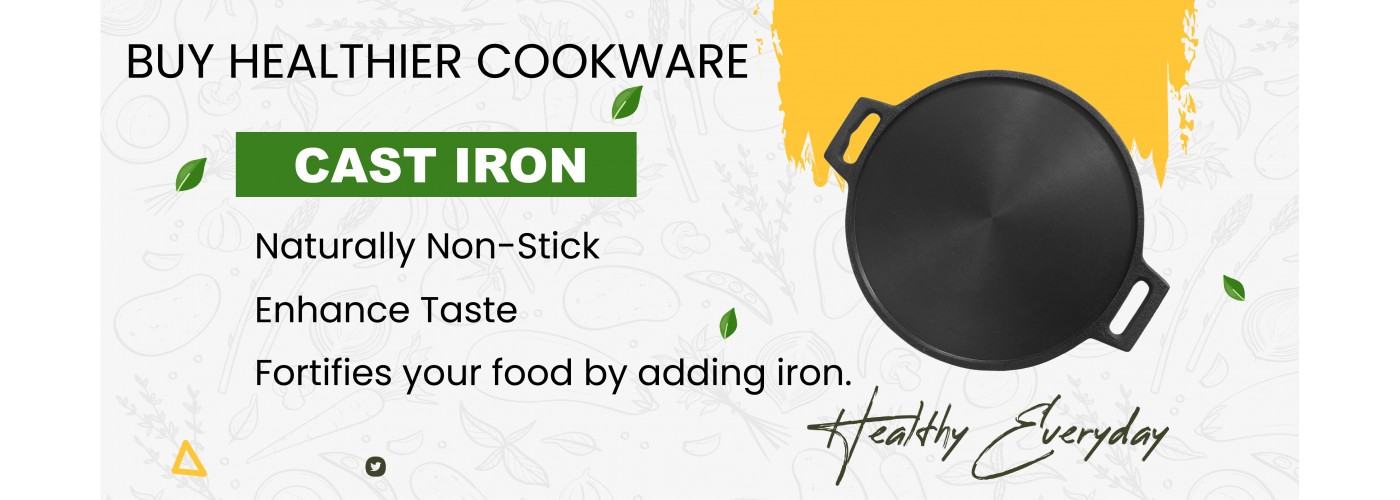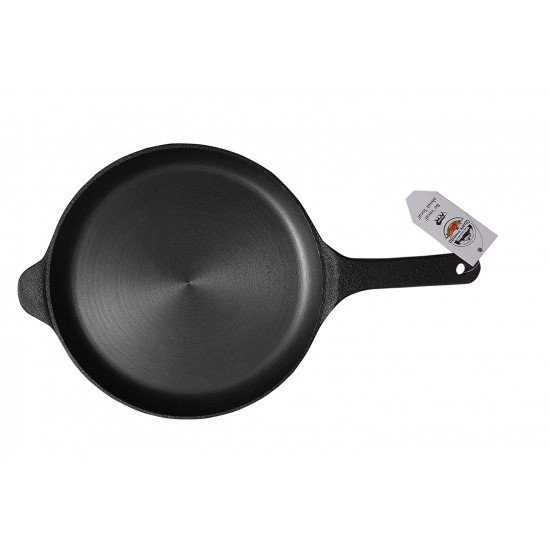
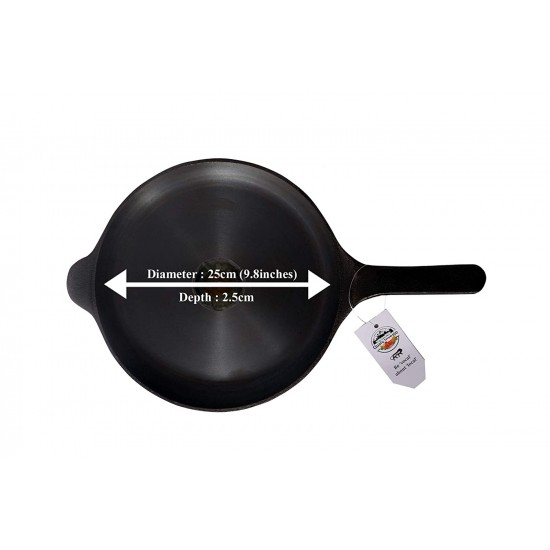
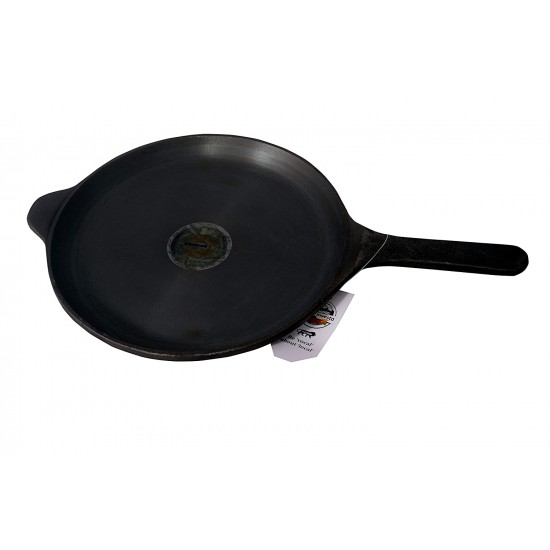
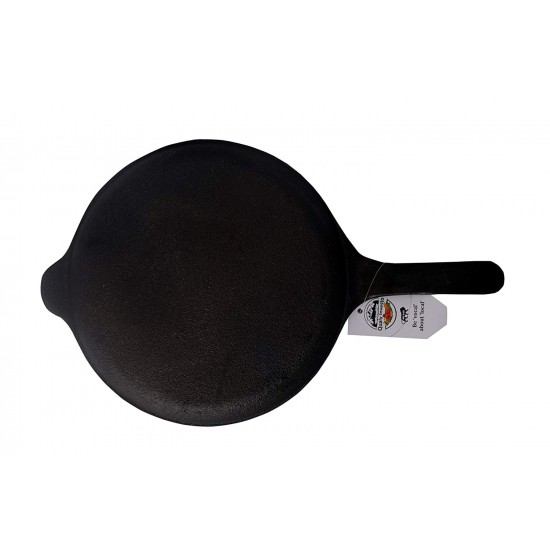




This product is Eligible for Free Shipping
Estimate Delivery Time : 2 - 5 Days
- 😋 Enhances taste
- 🌿 Naturally Non-stick
- 💪 Adds Iron (Iron+) to Food
- ✅ Certified Heavy Metal Free
- Stock: In Stock
- Model: Dosa Tawa Omlette Pan
- Weight: 1.60kg
- Dimensions: 25.00cm x 25.00cm x 3.00cm

Our Cast Iron Dosa Tawa is free from chemicals. We never use cadmium and enamel for coating as it contains certain percentage of lead. Our products are natural and good for health.
Key Product Features:
- Material - Cast Iron; Colour - Black; Size - 9.8 inch; Thickness - 5 mm; Weight -1.6 Kg
- No Chemical coatings such as cadmium and Enamel
- Fit for usage on gas, electric or induction stovetops.
- Pre Seasoned and User should season it as per the instruction sheet provided with the product.
Myth 1: "Cast iron is difficult to maintain."
The theory: Cast iron is an iron material that is prone to chip, rust or break easily. A cast iron skillet is similar to adopting an infant and puppy simultaneously. You'll need to take care of it during the first few months of its existence, and be careful when storing it. The seasoning could be smashed off!
The Truth: Cast iron is hard as nails! There's a reason that there are old cast iron pans that are spotted at auctions or antique shop. They're built to last and it is extremely difficult to destroy them completely. The majority of new pans come already seasoned, which means the work is completed and you can begin cooking straight away.
How do you store it? If your seasoning has been built up in a lovely thin even layer as it is supposed to be, don't be concerned. It won't chip away. I keep all my cast-iron pans directly into each other. Do you know how many times I've scratched their seasoning? Try it on your non-stick pan without damaging the surface.
Myth No. 2: "Cast iron heats really evenly."
Theories: Searing steaks and fries require an intense, even temperatures. Cast iron is fantastic for grilling steaks, and it must be great for warming evenly, isn't it?
The Truth: Actually, cast iron is poor in distributing heat evenly. The thermal conductivity--a measure of the capacity of a material's ability for transferring heat between one area to another to a quarter of the aluminium material. What is the significance of this? Place a cast-iron skillet over a flame and you'll find yourself creating clearly visible hot spots just above the place where the flames are and other parts of the skillet remain cool.
The major benefit of casting iron is its extremely high volumetric heat capacity This means that once it's heated, it remains hot. This is crucial in searing meat. To ensure that cast iron is heated evenly, set it in front of the flame and let it heat for about 10-minutes or more, turning it time. Alternately, you can heat it in an oven that is hot for 20-30 minutes (but make sure to employ dish towels or a potholder!)
Another benefit is its high emissivity, that is, its ability to release a significant amount of heat energy off its surface as radiation. It has an emissivity that is around 0.07. Even in the hottest temperatures it is possible to put your fingers in its vicinity and not feel anything. Only food in direct proximity to it will be heated or in some way.
Cast iron however has a staggering 0.64 emissivity score meaning that when cooking with it, you're more than just cooking the surface that is in contact with the iron and cooking plenty of food over it too. This makes it perfect for cooking things like hash, or roasting vegetables and chicken.
Myth 3 "My properly seasoned, cast iron skillet is just as nonstick as any non-stick pan that is out there."
Theories: The better you get your cast iron seasoned and the less stick-free it will become. Cast iron that is properly seasoned should be totally non-stick.
The Facts: Your cast iron pan (and mine) might be truly non-stick. It's non-stick enough that you can cook an omelet inside it and fry eggs without a issue, but let's be serious about it. It's nowhere near the same as, like, Teflon, a material so non-stick we had to come up with new techniques to make it bind in the middle of the pan. Do you think it's possible to dump a load of eggs in the cast iron pan and slowly heat it up , using no oil, and then take eggs that have been cooked out, leaving no trace in the middle? You can do it with Teflon.
Well, I didn't.
However, all macho swagger aside, as long as your cast iron pan is well-seasoned and you make sure you heat it thoroughly prior to adding any food items, you should have no issues whatsoever sticking.
Myth 4: "You should NEVER wash your cast iron pan using soap."
The theory: Seasoning is a thin layer of oil that covers the interior of your pan. Soap is designed to eliminate oil, and therefore soap could cause damage to the seasoning.
The Truth: Seasoning is actually not an extremely tiny layer of oil; it's a thin layer of the polymerization of oil, which is a crucial difference. When a pan is properly seasoned, such as a cast iron pan which has been rubbed with oil and repeatedly heated and then cooled, the oil has disintegrated into a plastic substance that has been bonded to the metal's surface. It is this that gives properly seasoned cast iron its non-stick characteristics and since the product is no longer being used as an oil product, any surfactants found in dish soap won't have any effect on the material. You can soap it up, then scrub it clean.
The only thing you should not do is Allow it to soak at the sink. You should try to cut down on the time between when you begin cleaning until you dry and then re-season your pan. If it means letting cook on your stove until dinner is ready then so be it.
Myth 5: "Don't use metal utensils on your cast iron skillet!"
The theory: The seasoning in cast iron pans can be delicate and is prone to flake or break if you use metal. Make sure to use nylon or wood kitchen utensils.
The Truth: The seasoning in cast iron is actually extremely robust. It's not stuck to the surface as tape, but it's chemically attached to metal. Scrape it off with an aluminium spatula and unless you're scratching the metal's surface, you can cook it without issue.
Do you ever notice small pieces of black material splinter off the pan when the food is cooked in? Then it's possible it's a sign of seasoning, but not likely. In order for my pan's seasoning to fall off I had to put my cast iron pan in an oven over about a month of drying and heating cycles, but without re-seasoning before I began to notice some signs of scaling.
The more likely scenario is that those flakes of black powder are likely fragments of food that stuck to the pan's surface due to your refusal to wash them off using soap the last time you cooked.
Myth No. 6 "Modern casting iron can be equally as good as older cast iron. It's the same material in the end."
The theory: Metal is metal casting iron cast. The latest version is not different from the old Wagner as well as Griswold pans from the 20th century that were adored by people.
The reality: The material may be the same, however the manufacturing methods have evolved. In the past casting iron pans were made using moulds made of sand followed by polishing the pebbly surfaces until they were smooth. The older cast iron is likely to have a smooth, satiny surface. As the 1950s approached, and production increased and became reduced, the polishing process was removed from the procedure. The result? Modern cast iron has the pebbly, bumpy surface.
The difference is much less than you believe. As long as you've prepared your pan appropriately, vintage and modern cast iron will develop an attractive non-stick finish. However, modern cast iron might not be as non-stick as the older material.
Myth 7: "Never cook acidic foods in cast iron."
The theory: Acidic food can react with the metal which causes it to leech into the food you eat, giving it the wrong flavour and could kill your body slowly.
The Truth: In a well-seasoned cast iron skillet the food inside the pan should be touching the polymerized layer inside the pan, not the actual metal. In a perfect world this shouldn't be an issue. However, none of us is perfect and neither are our pots. However well you cook, there's an opportunity that you'll find spots made of metal that may react with acidic substances in food.
It's best to stay clear of prolonged simmering of acidic foods, especially tomato sauce. However it's not going to cause harm. I use deglazing wine after cooking chicken almost every day.
How to Use The Cast Iron Skillet
These are the sole guidelines that you should know in order to ensure a long-lasting and successful connection with the cast iron.
It is time to season it after you receive it. Even pre-seasoned cast iron could need some additional protection. To add seasoning to your skillet prepare it by heating it on the stove until burning hot. Then rub a small amount of oil in it , and let it cool. Repeat the process several times, and you're good to start.
Clean it up after every use. Clean your pan thoroughly after each use , washing it in soap and water , and then scrub off any debris or gunk off the pan's bottom. I like using the scrubby part of a sponge to do this.
It is then re-seasoned. Rinse out any extra soap using water and place the skillet in a pan that is set to high. If the majority of the liquid inside the skillet has evaporated and the skillet is dry, you can add a half teaspoon of neutral oil, such as vegetable oil or flaxseed oil, canola or shortening. Rub it using a towel. Keep heating it until it begins to smoke. Give the pan a vigorous rub. Allow it to cool, and then you're done.
Fry and Sear in it. The best way to ensure your seasoning is maintained? Use your pan often! The more you cook or sear, bake, or cook inside it, the better your seasoning will be.
Don't let it get in the water. Water is the iron's natural enemy and the mere act of letting a drop of water remain in the pan until you take it out of the oven could cause an iron rust spot. This isn't necessarily a problem However, rust requires the need for a bit of scrubbing and reinforcing. I dry out my pan using an old towel and then coat it with a small amount of oil prior to storing it.
Ask for Review
Review Us
